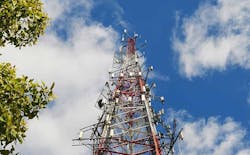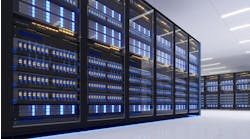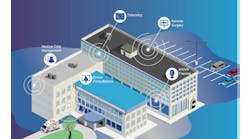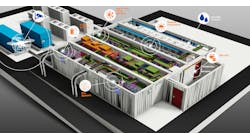American Tower Acquires Colo Atl in First Foray Into Data Centers
American Tower, the world’s largest owner of wireless infrastructure, has made its first acquisition in the data center sector by buying Colo Atl, a colocation and meet-me room business in downtown Atlanta.
The deal isn’t huge by data center standards, as Colo Atl operates about 26,000 square feet of colocation space across two floors. But it marks the arrival of an intriguing new player on the data center acquisition scene, as American Tower reveals its strategic interest in the interconnection business.
The deal continues the growing overlap between the data center and wireless worlds, a trend we first noted in our 2018 forecast (8 Trends That Will Shape the Data Center Industry in 2018). With the emergence of edge computing, a growing number of wireless companies have been acquiring assets in the data center sector, preparing for a future with greater integration between data centers, telecom towers and antennas.
American Tower has been actively exploring opportunities in edge computing. Much of this planning is focused on monetizing edge capacity at its thousands of tower sites, but the Colo Atl acquisition could be a bet that the earliest edge growth may involve creating denser networks in cities. The company says it will use the acquisition to “evaluate the interconnection marketplace directly as a complement to future edge data center growth.”
Connectivity Hub in Atlanta
Colo Atl provides carrier-neutral colocation and interconnection services from 55 Marietta Street, one of the carrier hotels in Atlanta. Colo Atl is owned and operated by Timothy Kiser, a 25-year industry veteran who designed more than 40 telecommunications facilities prior to the 2001 creation of JT Communications, the parent of the Colo Atl business. The deal was announced earlier this week by Bank Street, the investment bank that represented the seller.
“I think it’s a triple win,” said Kiser. “This works well for us, provides American Tower with an opportunity to get into a new vertical, and it’s a win for our tenants because they’ll have more business opportunities.”
Colo Atl has more than 100 customers, who can send data across one another’s networks through a cross connect – the physical connection between networks that knits the Internet together. The connections between tenants and carriers occur within the Meet Me Room (MMR), where Colo Atl embraces a model with no monthly recurring cross connect fees.
Colo Atl operates 26,000 square feet of colocation space on the 5th and 8th floors of 55 Marietta. The facilities are connected by vertical fiber risers, as well as diverse fiber that runs across the street to 56 Marietta, another carrier hotel with an even larger tenant base. Both buildings are in downtown Atlanta, a short walk from the CNN Center and Centennial Olympic Park.
Colo Atl is also home to the Georgia Technology Center (GTC), a live laboratory for network equipment vendors to highlight their latest optical hardware, and the Southeast Network Access Point (SNAP), which provides next-generation Internet Exchange (IX) solutions, including SDN peering.
Kiser said he and his team will continue under American Tower’s ownership. “They don’t want to change anything, other than that they want to grow the product,” said Kiser. “American Tower has a lot of relationships with folks who may want to colocate here with us. From a marketing perspective, they can have a bigger outreach.”
Strategic Implications
What does the Colo Atl acquisition tell us about American Tower’s interest in the colocation and interconnection business? Kiser said he has no details on American Tower’s long-term strategy, other than taking some time to operate the Atlanta facilities and learn the colocation and interconnection business. But he sees the addition of Colo Atl as a logical extension of the tower business.
“It’s a smart move,” said Kiser. “They’re looking at this as another potential vertical where they can make some money. The two businesses are related. The towers are out at the edge, and the fiber providers bring the data back here to the core.”
American Tower doesn’t usually do anything small. The company operates more than 170,000 wireless infrastructure sites across 17 countries on five continents, including nearly 40,000 in the United States, and had more than $7.3 billion in revenue in 2018. In addition to leasing space on towers, American Tower provides access to in-building systems, outdoor distributed antenna systems (DAS), managed rooftops and services that speed network deployment.
Indeed, American Tower appears to have big ambitions for expanding beyond its core tower market. In late 2017 the company created an “innovation intiative” to expand into adjacent businesses.
“This transaction, completed through our innovation program, will enable American Tower to evaluate the interconnection marketplace directly as a complement to future edge data center proliferation and network resiliency initiatives on the path towards 5G,” said John Ghirardelli, Director, U.S. Innovation for American Tower and new General Manager for Colo Atl. “The combination of a strong existing business, a clear path towards additional growth and the opportunity to leverage Colo ATL’s unique position in the data center space to learn more about the convergence of network connectivity around 5G was extremely attractive for us.”
“This focus on innovation has long been an integral part of American Tower’s strategy and we believe has the potential to eventually contribute significantly to our growth on a global basis and specifically in the U.S.,” said President and CEO James Taiclet in early 2018. “We’ve set an aspirational goal for innovation-related initiatives to be a driver of up to 25 percent of our run rate revenue 10 years out, with a return on investment profile comparable to that of our current business.”
In American Tower’s fourth-quarter earnings call, Taiclet outlined some of those new market opportunities.
“Early stage projects are underway and include everything from Edge Data Centers to a potentially significant expansion of our end-building coverage capabilities through CBRS spectrum, to explore a possible role in future autonomous driving in joint control networks,” said Taiclet, according to a transcript.
Control networks for autonomous cars are part of the vision for smart cities, with the potential to revolutionize traffic congestion by allowing location-aware smart cars to “talk” to one another and the surrounding infrastructure, including traffic lights and parking meters. These networks would have the greatest impact in cities, but would also need to extend nearly everywhere cars can drive – which would create an opportunity for infrastructure companies with a distributed network of towers.
The Data Center Landscape
American Tower’s interest in data centers comes as the industry’s investment landscape has entered a new phase, as Data Center Frontier noted in a recent analysis (New Investors Boost Construction, Competition in Data Center Sector). A new class of investors has emerged, including infrastructure funds and sovereign wealth funds with deep pockets and extended time horizons. Most of these new players are targeting the growth of wholesale and build-to-suit data centers for hyperscale operators.
The new players have also included wireless real estate specialists, led by Digital Bridge, which acquired DataBank and Vantage Data Centers, and is using them to build national platforms in retail and wholesale, respectively. Other rising data center players with wireless pedigrees include EdgeConneX and Stonepeak Infrastructure Partners, which acquired Cologix.
Edge computing is in an early stage of evolution (see Investing in Edge Computing: It’s Still Early). A group of edge-focused startups has been funded primarily by private equity firms, angel investors and founders. Some are also being backed by corporate partners like tower operator Crown Castle, one of American Tower’s chief rivals, which is an investor in edge computing specialist Vapor IO.
American Tower has taken a more deliberate approach, studying the evolving edge market. As a publicly-traded real estate investment trust (REIT) focused on data infrastructure, it is optimized for acquiring properties. It also has lengthy experience financing growth, including the use of securitized bonds backed by its tower assets, which can provide a lower cost of capital (see our recent story on Vantage Data Centers’ use of securitization financing).
Buying Colo Atl suggests American Tower sees interconnection as a key piece of future growth. Interestingly, one of the partners in JT Communications/Colo Atl is Hunter Newby of Newby Ventures, an industry veteran with a keen interest in Internet architecture and where networks connect. Newby was a pioneer in interconnection as an executive at Telx at 60 Hudson Street, and has recently invested in cable landing stations and carrier hotels.
Are Carrier Hotels Actually Edge Hubs?
The Colo Atl deal puts a spotlight on the potential value of carrier hotels, buildings in the central business district of major cities that serve as hubs for network connectivity, attracting dozens of providers. Carrier hotels became the early cornerstones of the Internet economy, and some of the most successful properties in the colocation industry. As we noted in 2015, surging interest in interconnection has made carrier hotels sexy again.
The busiest recent player in this niche has been Netrality Properties, a joint venture between developer Amerimar Enterprises and Newby, which has assembled a portfolio of carrier hotels in New York, Philadelphia, Chicago, Houston, Kansas City and St. Louis. Netrality typically acquires a site and upgrades its Meet Me Room to boost interconnection activity and attract more colcoation tenants.
Following a similar playbook, H5 Data Centers recently acquired 100 Taylor Street, the primary telecom building in San Antonio, and will invest in upgrades to the Meet Me Room to operate the 85,000 square foot building as a carrier-neutral data center.
The relevance of carrier hotels in the cloud era is reinforced by the recent efforts to add capacity at the most prominent buildings:
- A 2017 renovation at One Wilshire, the leading carrier hotel in Los Angeles, brought infrastructure upgrades that will add up to 28 megawatts of power capacity for the 30-story building.
- Equinix is investing $138 million to add a second building at the Dallas Infomart, and investing $60 million in an expansion of the NAP of the Americas in Miami, the primary carrier hotel in south Florida.
- DataGryd is building out new space within 60 Hudson Street, the most prominent carrier hotel in Manhattan.
Time to Hand Off
Carrier hotel businesses don’t change hands often, as they tend to be strong businesses with a limited pool of acquirers. Kiser said that it was time to seek a larger partner.
“After more than 17 years, I wanted to let go of the stress,” said Kiser. “It’s a 24-by-7 business. I have to always carry my phone. I carefully select all the people who work for us. You can’t afford mistakes.”
That focus on engineering allows Kiser to hand off the business with an enviable track record – in more than 17 years of operation, he says, his data center never suffered any downtime.






